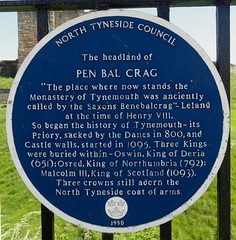King Malcolm III
Commemorated on 5 plaques
The headland of Pen Bal Crag. "The place where now stands the Monastery of Tynemouth was anciently called by the Saxons Benebalcrag" - Leland at the time of Henry VIII. So began the history of Tynemouth - its Priory, sacked by the Danes in 800, and Castle walls, started in 1095. Three Kings were buried within - Oswin, King of Deria (651); Osred, King of Northumbria (792); Malcolm III, King of Scotland (1093). Three crowns still adorn the North Tyneside coat of arms.
Front Street, Tynemouth, United Kingdom where they was buried near
Abernethy Round Tower. This tower and the similar tower at Brechin, in Angus are the only two round towers of the Irish Celtic type in Scotland. Here the Romanesque windows of the befry suggest that the tower was built in the later 11th Century. Long before this Abernethy was important as a principal seat of a Celtic Bishopric. Malcome Canmore and William the Conqueror met at Abernethy in 1072 possibly here.
, Abernethy, United Kingdom where they was (1072)
Malcolm Canmore's Tower. There is no historical mention of the Tower of Dunfermline until about A.D. 1070, when Malcolm Canmore and his Queen - Princess Margaret - celebrated their wedding. Dunfermline takes its name from three Celtic words - dun (a hill or fort) fearam (bent or crooked) lin, lyne or Line (a pool or running water). The tower was adopted at an early date for the burgh arms of Dunfermline, and old wax seals show it to have been a building of two storeys with attic about 52 feet from east to west, and 48 feet from north to south. It contained about twenty small apartments. Before the roadway to the south, which was the western access to the town, was formed, the tower, perched on its peninsular rock, was an almost impregnable fortress. This fact no doubt led to Dunfermline's motto "Esto Rupes Inaccessa". Historians are of opinion that the tower was where "The king sits in Dunfermling toon drynking the bluid-red wyne".
Pittencrieff Park, Dunfermline, United Kingdom where they lived near
Malcolm Canmore's Tower. Traditionally accepted as the site of the Tower House of King Malcolm and Queen Margaret (c. 1069). The name Dunfermline means 'fortress by the crooked stream'.
Pittencrieff Park, Dunfermline, United Kingdom where they lived
Monastic Buildings. The Benedictine Monastery, established by King Malcolm III at the behest of Queen Margaret in the 1070s and enlarged by David I, became the richest and most powerful Abbey prior to the Reformation in Scotland. Some of the building date from the 13th century.
Dunfermline Palace & Abbey (ruins), Dunfermline, United Kingdom where they established






